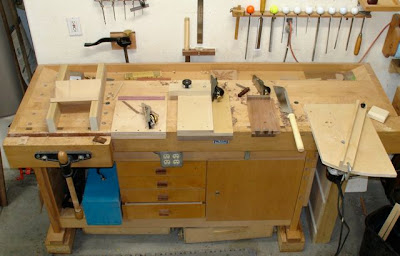 |
| Ready for .......? |
I've mentioned that I'm gearing up for a show this September which will feature various small boxes that are currently under construction and in the design stages. I'm playing around with several different and unique styles and hope they will appeal enough to the public so they'll vote with their wallets! Another advantage is that these will be an easier item to ship than furniture is.
Just because they're small really doesn't make them any easier to build, if anything, the smaller sizes add the challenge of how to hold them, especially if there's machine work involved. I sure am fortunate to have Diane as my style guide, she has an eye for the way things go together and work out style wise. As an example, the two toned lid in the upper left was designed to go with the box that has the extended and pegged finger joints. She suggested that there was too much going on, either the box should be the star or else the lid should be the star. I took that into consideration and it makes perfect sense to me but not until she pointed it out did I truly see it. That lid will go on the box in the right of the picture which features some curly Maple and mitered corners with Cherry splines as a contrast. The lid that currently has the clamp on it will be for the finger jointed box. I created a different pull for it that mimics the joinery on the box. This box was tricky to assemble and finish:
 |
| Extended & Pegged Finger Joints |
The tricky part comes in after you figure out how to clamp and glue this box together. You have to be careful not to get glue on the part of the joint that extends and once that's accomplished the area between the two joints (short side) is hard to get to. Time consuming process but I'm thinking that the final design is worth it but.....is it a money maker? Probably not but I really just need enough profit to feed my wood addiction!
See the big, blue brush? That's something I just purchased which seems like such a good idea but fell short. It's made by Rockler and the bristles are silicon so glue will not stick to it. The advantage is that you can let it go and once the glue is cured it will peel right off. Good concept right? However, it is so big and awkward I couldn't get it between the joints without making a mess all over the place. I'm going to stick to the little acid brushes, they're washable and last for 4-5 projects before the bristles come out. Check this out:
 |
| Gorilla Glue |
I had used it the night before to laminate two pieces together for a lid. For that I prefer a polyurethane glue (Gorilla Glue) so I used this brush for it. Large and cumbersome but did the job. The next morning I attempted to clear away the dried glue but it hadn't cured completely which resulted in my fingers getting permanently stained! When I use Gorilla Glue it's about the only time I ever wear gloves, you can't get the stains off of your skin easily so it's just there until a new layer grows in. Once the glue cured completely it did pull off of the bristles with some effort. Like I said, it's a good idea but I'm not a fan.

















































